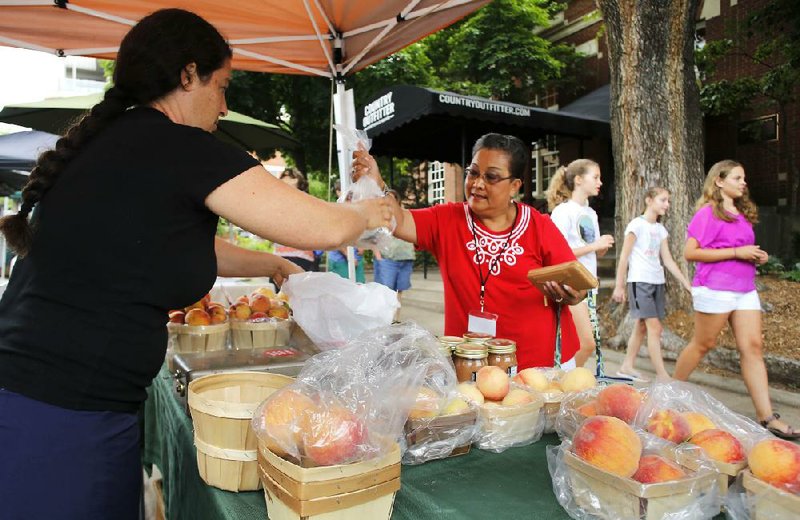FAYETTEVILLE -- One 22-year-old college student started a business at age 13 that now includes managing 200 head of cattle and 100 head of sheep.
Another 19-year-old was a junior in high school when he was asked to serve on a Native Voices board for the U.S. Agriculture Department. He plans to become a lawyer and raise cattle on the side.
They were among 43 American Indian high school students and young adults who spent last week in Northwest Arkansas attending the Summer Leadership Summit: Native Youth in Agriculture, organized by the University of Arkansas School of Law and the school's Indigenous Food and Agriculture Initiative.
American Indian tribes are taking an interest in exporting foods to foreign countries. They are raising large herds of livestock, and some are working to reinvigorate traditional foods, which can include different types of corn, squash and beans, said Janie Simms Hipp, a Chickasaw Nation citizen who directs the Indigenous Food and Agriculture Initiative.
But farming and ranching, particularly on Indian lands, can present challenges, especially with complex legal issues governing the ownership of Indian lands and access to credit, Hipp said. The initiative aims to help tribal governments by developing model laws to support agriculture. Another focus is on youth education.
Last week's conference drew students who have been active in food and agriculture from places as far away as Hawaii, the Pacific Northwest and South Dakota, and from nearby Oklahoma, Hipp said.
Hipp is an attorney with expertise in agricultural law. She taught at UA from 1992 to 2007 before she was tapped to work for the USDA. There, she founded the agency's Office of Tribal Relations and was senior adviser for that office to Agriculture Secretary Tom Vilsack.
She returned to the university in 2013 to oversee the indigenous food initiative.
Learning the ropes
The visiting students spent most of their time on the UA campus, but the week included learning from potential business contacts at Tyson Foods' world headquarters, the Regional Distribution Center of Wal-Mart and Sam's Club world headquarters.
On Thursday, the students spent time talking with vendors at the Fayetteville Farmers' Market about how to have long-term success in a market, Hipp said.
Odessa Oldham, 22, learned an early lesson from her father about researching the market, she said. Oldham, a Navajo citizen who lives in Wyoming and is attending the University of Wyoming, was 13 when she started a business through Future Farmers of America that led to her producing all-natural beef and lamb.
In her first year, she was preparing to sell calves and planned to sell all of the heifers and steers together at a sale barn, Oldham said. Her father, however, told her she should split the heifers from the steers because she could get more money for the heifers.
She has since learned to advertise her heifers to see if any local ranchers want to buy them, and if not, she takes them to auction and now knows to sell heifers and steers separately, she said. She's also learned to talk to older cattlemen and to do more research.
"You need to know which one you're going to make more money on," she said. "You want to make enough money incomewise so you can continue your business."
Some youths in agriculture don't have an adviser like her father, and Oldham said she hopes conferences like the one at UA help teenagers and young adults get involved in agriculture and avoid some of the mistakes she made when starting her business.
Oldham suggested to Hipp the idea of an annual meeting of American Indian students interested in agriculture. Oldham met Hipp in 2011 as one of 10 students invited to a National Future Farmers of America Native Voices event in Washington, D.C., that focused on advocating for agricultural education for young American Indians.
Last week, one session provided Oldham with an outline for creating an agriculture business plan that she will compare with her existing plan to see if she can increase productivity and efficiency, she said.
Getting involved
Ridge Howell, 19, of Checotah, Okla., grew up in a family that raises beef cattle.
Howell, who will begin his sophomore year of college at Oklahoma State University in August, said he thinks future American Indian leaders need to know why agriculture is important and why they need to be involved.
"We don't have very many young farmers coming up," he said. "How can you be a sovereign nation if you don't have control of your own food sources?"
He began showing cattle at age 9 and was active in Future Farmers of America in high school, he said. Howell is a member of the Muscogee (Creek) Nation. He met Hipp twice before last week's conference, including during the Native Voices event in 2011.
As the world's population continues to grow, he is concerned that farmers will need new and innovative ways to produce more food. Howell said he thinks there will be a need for more farmers.
The conference included classes and activities focused on legal issues in agriculture, business management and marketing, Hipp said. The USDA Risk Management Agency provided $80,000 for the conference, and the Farm Credit Council, a national trade organization, contributed $15,000, she said.
Metro on 07/28/2014
